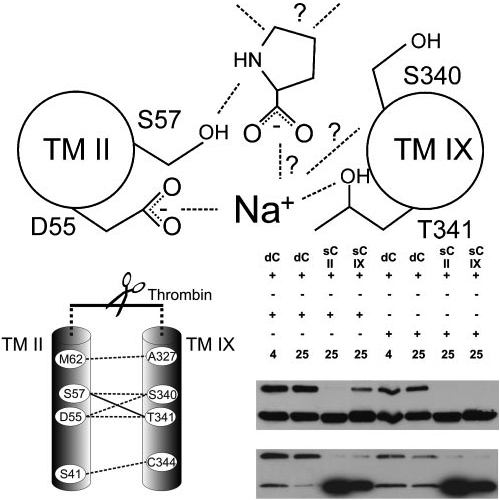Role of Ser-340 and Thr-341 in Transmembrane Domain IX of the Na+/Proline Transporter PutP of Escherichia coli in Ligand Binding Transport
22-Feb-2008
Journal of Biological Chemistry, 2008, 283 (8), 4921-9 published on 22.02.2008
Journal of Biological Chemistry, online article
Journal of Biological Chemistry, online article
The Na+/solute symporter family comprises more than 400 members of pro- and eukaryotic origin. Using the Na+/proline transporter PutP of Escherichia coli as a model, the role of two conserved residues, Ser-340 and Thr-341, is investigated to obtain insights into the mechanism of transport catalyzed by members of this family. Substitution of these amino acids alters the transport kinetics of cells and proteoliposomes containing the PutP variants significantly. In particular, the apparent affinities for Na+ and Li+ are reduced by 2 orders of magnitude or more. Also proline binding is affected, albeit to a lesser extent than ion binding. Thereby, the presence of a hydroxyl group at position 341 is essential for high affinity ligand binding. Furthermore, Cys placed at position 340 or 341 reacts with sulfhydryl reagents of different polarity, indicating accessibility from the water phase. In addition, Cys cross-linking suggests proximity of the residues to other amino acids previously shown to be crucial for ligand binding. For these reasons it is suggested that Ser-340 and Thr-341 are located in a ligand translocation pathway. Furthermore, it is proposed that the side chain of Thr-341 directly participates in Na+ binding. The Na+/solute symporter family comprises more than 400 members of pro- and eukaryotic origin. Using the Na+/proline transporter PutP of Escherichia coli as a model, the role of two conserved residues, Ser-340 and Thr-341, is investigated to obtain insights into the mechanism of transport catalyzed by members of this family. Substitution of these amino acids alters the transport kinetics of cells and proteoliposomes containing the PutP variants significantly. In particular, the apparent affinities for Na+ and Li+ are reduced by 2 orders of magnitude or more. Also proline binding is affected, albeit to a lesser extent than ion binding. Thereby, the presence of a hydroxyl group at position 341 is essential for high affinity ligand binding. Furthermore, Cys placed at position 340 or 341 reacts with sulfhydryl reagents of different polarity, indicating accessibility from the water phase. In addition, Cys cross-linking suggests proximity of the residues to other amino acids previously shown to be crucial for ligand binding. For these reasons it is suggested that Ser-340 and Thr-341 are located in a ligand translocation pathway. Furthermore, it is proposed that the side chain of Thr-341 directly participates in Na+ binding.











